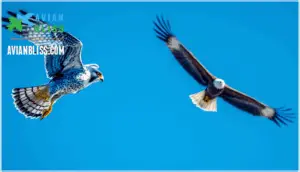This site is supported by our readers. We may earn a commission, at no cost to you, if you purchase through links.

These birds aren’t simply rivals in myth and legend; their differences in speed, strength, and strategy shape every aspect of their lives. Understanding falcon vs eagle goes beyond measuring wings and talons—it opens a window onto two master hunters, each ruled by their own laws of the sky.
Table Of Contents
- Key Takeaways
- Falcon Vs Eagle Size
- Speed of Falcons and Eagles
- Hunting Styles of Falcons and Eagles
- Physical Features of Falcons and Eagles
- Habitat and Behavior of Falcons and Eagles
- Diet and Feeding Differences
- Nesting and Breeding Differences
- Combat Skills of Falcons and Eagles
- Unique Behavioral Differences
- Taxonomy and Evolution
- Frequently Asked Questions (FAQs)
- Who is stronger falcon or eagle or Hawk?
- Which is faster, an eagle or a falcon?
- Are falcons and eagles related?
- Which is the strongest bird in the world?
- What are the eyesight differences between falcons and eagles?
- How do falcons and eagles communicate?
- What are the known predators of falcons and eagles?
- How do falcons and eagles choose their mates?
- Are falcons or eagles more common worldwide?
- How do falcons and eagles adapt to urban environments?
- Conclusion
Key Takeaways
- Eagles dominate in size and strength with wingspans reaching 8 feet and weights up to 15 pounds, while falcons stay lightweight at 1-4 pounds with 2-4 foot wingspans, trading mass for agility and speed in their hunting strategies.
- Peregrine falcons are Earth’s fastest animals, diving at 240 mph to stun prey mid-flight, whereas eagles rely on patient ambush tactics and raw power to overpower larger prey like fish and small mammals.
- Despite sharing the sky as top predators, falcons and eagles are not closely related—they belong to separate families (Falconidae and Accipitridae) with distinct evolutionary paths spanning millions of years.
- Their physical adaptations reflect specialized survival strategies: eagles use heavy curved beaks and powerful talons for crushing force, while falcons feature pointed beaks with a unique tomial tooth and sleek feathers engineered for high-speed precision hunting.
Falcon Vs Eagle Size
Regarding size, falcons and eagles are two very different birds. You’ll notice these differences right away, from their weight to the span of their wings. Here’s how their key measurements stack up.
Weight Comparison
When you stack up the numbers, eagles tip the scales with a heft that leaves most falcons looking downright lightweight. For instance, the average weights show eagles reaching up to 15 pounds, while falcons rarely exceed 4.
| Species | Average Weights | Weight Variability | Weight Impact |
|---|---|---|---|
| Eagles | 6–15 lbs | High | Power, size |
| Falcons | 1–4 lbs | Moderate | Speed, agility |
Wingspan Comparison
After considering their hefty weights, it’s clear the real showstopper comes from watching just how far these birds stretch their wings. Eagles master the air with wingspans surpassing 7 feet—true icons of Soaring Ability and Flight Efficiency. Falcons keep it nimble, with around 3.5 feet, engineered for speed and precision hunting.
Here’s a quick Eagle vs Falcon Comparison:
| Species | Average Wingspan | Habitat Adaptation |
|---|---|---|
| Eagles | 6–8 feet | Broad fields, open sky |
| Falcons | 2.3–4 feet | Varied, urban/rural |
Length Comparison
If you thought wingspan was impressive, wait until you see how these birds measure up from beak to tail. Eagles outclass falcons in average lengths—towering with bodies up to 40 inches, while falcons top out around 24. That difference in body proportions and tail lengths isn’t just for show—it’s vital for their role as top birds of prey.
| Feature | Average Eagle | Average Falcon |
|---|---|---|
| Body Length | 28–40 in | 8–24 in |
| Tail Length | Long, sturdy | Short, sleek |
| Dimorphism | Marked | Less so |
Examples of Large and Small Species
Imagine a bird so big its shadow startles the forest—meet the Philippine Eagle, the heavyweight of Accipitridae. On the flip side, small falcons like the American Kestrel pack a punch in a fraction of the space. Such extremes in Weight Ranges and Wingspan Variation reveal how Species Comparison spotlights their different hunting arenas and bold adaptations. The eagle is considered the world’s largest eagle based on length and wing surface.
| Species | Weight | Wingspan |
|---|---|---|
| Philippine Eagle | 20 lbs | 7 ft |
| Gyrfalcon | 5.8 lbs | 4.4 ft |
| American Kestrel | 4.1 oz | 24 in |
Speed of Falcons and Eagles
When you think about falcons and eagles, their speed sets them apart in dramatic ways. You’ll notice some impressive differences in how fast they fly and hunt.
Let’s break down the key facts about their speed.
Diving Speeds
Blink and you’ll miss it—falcons dive through the air faster than any other animal on Earth, leaving eagles trailing in their wake. Peregrine Falcons, shaped by speed adaptations and sharp dive angles, reach up to 240 mph.
This staggering velocity, evolved for hunting strategies at high altitude, delivers a powerful prey impact unsurpassed by any eagle’s flight patterns or speed.
Level Flight Speeds
There’s a clear difference in how eagles and falcons move when they’re cruising along in level flight, and it all comes down to their unique wing shapes and flying styles.
Falcons dart across the sky, trading energy for speed, while eagles rely on broad wings for sustained flight.
Environmental influence shapes these flight patterns—speed versus endurance—making the Eagle Vs Falcon comparison fascinating.
Comparison of Speeds
How do falcons and eagles stack up regarding pure speed, and what does that mean for their place in the sky? Falcons win the dive comparison, reaching breakneck acceleration rates, while eagles excel in sustained speed. Here’s what sets them apart:
- Dive comparison
- Acceleration rates
- Sustained speed
- Flight muscles
- Aerodynamic differences
Examples of Fastest Species
If you’re chasing records, the Peregrine Falcon leaves every rival behind with a Falcon Dive Speed of 240 mph—faster than any living creature. The Golden Eagle, an icon of power, reaches 200 mph in its own high-velocity dives.
These Speed Adaptations, from sleek bodies to muscle-packed wings, shape each species’ dominance across their global Species Distribution. These birds are among the fastest species on Earth.
Hunting Styles of Falcons and Eagles
Regarding hunting, falcons and eagles each have their own style. You’ll notice some key differences in how they track, attack, and secure their prey. Let’s look at what sets their hunting methods apart.
Ambush Tactics
When an eagle sets its sights on prey, it’s like watching a shadow slip across the landscape—silent, calculated, and nearly invisible until the final strike. Eagles rely on stealth techniques and terrain advantage, blending in with expert camouflage use. Their patience is unparalleled, making surprise attacks a hallmark of eagle hunting techniques and predatory behavior.
- Stealth Techniques
- Terrain Advantage
- Camouflage Use
- Patience Factor
- Surprise Attacks
Dive-Bombing Tactics
If you’ve ever imagined a feathered missile streaking toward earth, the falcon’s dive-bombing attack is the closest thing you’ll find in nature. Falcons control speed and dive angles with surgical precision, targeting prey for maximum impact.
Eagles, though slower, use environmental factors and powerful hunting techniques to strike. Each bird’s combat skills reflect its mastery of aerial hunting.
Comparison of Hunting Styles
Watching these birds hunt is like witnessing two masters at work—one relying on lightning-fast dives and the other on patient, powerful ambushes. Falcons, with peerless agility, use aerial maneuvers for rapid prey capture. Eagles, built for strength, excel at ambush tactics and cooperative hunting. Each bird’s hunting style reflects unique adaptations to their environment and showcases the diversity of raptor hunting techniques.
- Falcons: Speed and precision in open skies
- Eagles: Strength and stealth near water or forests
- Both: Adapt hunting skills to optimize hunting success
Examples of Successful Hunts
You’ve just seen how hunting styles shape predator-prey dynamics. Now, let’s look at real hunts: Peregrine Falcons reach up to 47% success rates using high-speed stoops, while Golden Eagles carry off mountain goats—prey heavier than themselves. Urban falcon hunts show sharp hunting adaptations, and cooperative hunting boosts falcon success. These raptors showcase:
- Lightning-fast attacks
- Remarkable strength
- Clever teamwork
Physical Features of Falcons and Eagles
When you look at falcons and eagles, their physical features tell a fascinating story. These details reveal how each bird survives and thrives in the wild. Let’s break down what sets them apart.
Beak Shapes and Sizes
Take a closer look at their beaks, and you’ll notice each is designed like a specialized tool—one built for brute force, the other for surgical precision.
Eagles showcase bill strength with heavy, curved beaks that crush bone, while falcons rely on pointed beak morphology for quick slicing.
These feeding adaptations reveal evolutionary pressures shaping hunting efficiency in birds of prey.
Talon Shapes and Sizes
Just as their beaks reveal a story of adaptation, the talons of these birds are shaped by the demands of their hunting lives. Eagles wield sturdy talon morphology for maximum grip strength and prey capture, while falcons favor slender, agile talons—ideal for aerial precision.
These raptor characteristics reflect evolutionary adaptations, balancing climbing ability with the specialized tactics unique to birds of prey.
Feather Characteristics
A closer look at feather composition reveals how flight adaptation sets these birds apart. Eagles display broad, thick plumage for soaring, while falcons sport stiff, compact feathers for speed.
Molting patterns and color variation can identify individuals, and feather stiffness aids their unique hunting styles. This birds of prey comparison highlights the subtle art behind falcon and eagle characteristics.
Eye Colors and Shapes
Across the wild skies, you’ll notice that the eyes of falcons and eagles hold secrets to their hunting mastery and personalities. Falcons display dark eyes with slit pupils—perfect for rapid focus and agility. Eagles, on the other hand, have pale, round eyes, built for visual acuity and long-distance hunting vision.
These shape adaptations and eye color variations reflect evolutionary advantages in birds of prey.
Habitat and Behavior of Falcons and Eagles
Falcons and eagles each have their own preferences regarding where they live and how they behave. You’ll notice some striking differences in their nesting sites, hunting grounds, and social habits.
Here’s what sets their habitats and behaviors apart.
Nesting Sites
Imagine building your home where the view stretches for miles—eagles and falcons each stake out their territory in ways that reveal just how differently they see the world. Eagles favor grand Nesting Sites, constructing massive eyries atop cliffs or tall trees. Falcons, meanwhile, choose modest Nest Locations, often in crevices or on ledges.
Urban Nesting is common for falcons, but eagles rarely adapt. Both fiercely defend their nests, reusing them year after year.
Hunting Grounds
Picture a chessboard spread across forests, fields, and city skylines—each square is a potential hunting ground where eagles and falcons play out their survival strategies.
Eagles claim vast territories with high prey abundance, while falcons excel in areas of territory overlap, adapting to human impact and habitat loss.
Conservation efforts shape their hunting skills, keeping these raptors thriving despite shifting landscapes.
Social Behavior
What happens when you put a royal eagle and a lone falcon in the same sky? Their social lives paint a vivid picture of rivalry, teamwork, and survival.
Eagles excel at pair bonding and family structure, defending territory with complex communication styles. Falcons, more solitary, rely on agility and sharp animal behavior—occasionally surprising you with brief teamwork among raptors.
Examples of Unique Habitats
Every avian species carves out its own ecological niche, and the diversity is striking. Falcons thrive in places you mightn’t expect—from skyscrapers to high cliffs—while eagles command wild, open spaces. Their habitat choices reveal adaptive mastery:
- Urban Falcon Nests atop city towers
- Eagle Wintering in forested territories
- Coastal Wetlands bustling with prey
- Mountain Cliffs offering panoramic hunting grounds
Diet and Feeding Differences
When you look at what falcons and eagles eat, their differences start to stand out. Each bird has its own way of finding food and managing a meal.
Here’s what sets their diets and feeding habits apart.
Prey Preferences
When you look at dietary adaptations in raptors, eagle prey size stands out—they go for fish or small mammals. Falcons, built for speed, target birds in flight.
Regional variations and seasonal prey shifts shape their menus, showing how hunting and diet strategies adapt. These predator-prey dynamics highlight hunting success and the flexibility of both species in changing environments.
Hunting Techniques
If you’re curious how these birds turn their prey preferences into real action, their hunting techniques reveal just how specialized and effective each species can be. Falcons stun with their speed and precision, while eagles rely on power and vision. Their hunting adaptations shape:
- Prey Capture strategies
- Hunting Success rates
- Cooperative Hunting in varied hunting ranges
Aerial hunters, indeed.
Scavenging Behavior
While falcons chase down fresh prey with acrobatic dives, eagles sometimes switch gears and snag an easy meal by scavenging, proving that even top hunters appreciate a shortcut now and then. Their Scavenging Behavior shapes where and how they feed, influenced by Carrion Consumption and Scavenging Competition. This adaptive strategy reveals how raptors adjust to shifting ecological niches:
- Increases Scavenging Frequency in lean seasons
- Highlights Diet and Hunting Strategies
- Balances habitat scavenging with predation
Examples of Unique Diets
Among raptors, diet specialization paints a vivid picture: eagles feast on fish and small mammals, occasionally turning opportunistic by scavenging. Falcons, shaped by ecological niches and regional variations, stick mainly to birds—think pigeon-heavy diets in cities.
In captivity, both require diets designed to match natural prey consumption, revealing the intricate balance of hunting and diet strategies.
Nesting and Breeding Differences
Every bird needs just the right home to raise their offspring, and falcons and eagles go about it in their own unique ways.
Their choices in nesting spots, materials, and egg care reveal a lot about each species. Let’s look at what sets their breeding habits apart.
Nesting Materials
Building a nest isn’t just about twigs and leaves—it’s a full-blown architectural competition between eagles and falcons. Here’s how their nesting habits stack up:
- Eagles choose large sticks for grand, reusable nests.
- Falcons stick to gravel, dirt, or even cliff ledges.
- Eagles build high in trees or cliffs.
- Falcons nest in open, exposed locations.
Egg-Laying Patterns
Out in the wild, how does a bird decide just how many eggs to lay at once? For eagles, clutch size is modest—one to three eggs, with soft shades blending seamlessly into their nest. Falcons go bigger, laying up to five speckled eggs.
This strategy, part of their breeding and nesting habits, boosts nesting frequency and parental care flexibility.
Incubation Periods
You might be surprised to learn that the countdown to hatch day runs on different clocks for eagles and falcons. Eagles invest in a longer incubation period, keeping their eggs warm for about 35 days, while falcons usually finish the job in just 28 to 32 days.
This tighter timeline for falcons means their chicks are out in the world—and ready for parental care—a lot sooner. Egg size, clutch size, and nesting habits all blend into the equation, shaping hatching success and each species’ unique breeding rhythm.
Examples of Unique Breeding Habits
Ever think of raptors as romantics? Both eagles and falcons practice tight monogamy fidelity, returning to the same partner and nest year after year. Eagles go big with fortress-like stick nests high in trees, while falcons pick cliff ledges or city ledges, favoring simplicity.
Their breeding habits—dramatic courtship displays and careful chick development—showcase clever nesting selection across generations.
Combat Skills of Falcons and Eagles
Regarding combat, falcons and eagles each bring a unique set of skills to the table. Their clashes are shaped by speed, power, and cunning.
Let’s look closer at what happens when these birds face off.
Fighting Techniques
Toe to toe in the sky, these raptors don’t just fight—they turn every clash into a high-flying spectacle worthy of its own legend. Eagles lead with brute talon strength, locking in with force, while falcons duck, weave, and strike with razor-sharp beaks.
Watch for these five Combat Skills in the fray:
- Sudden dives
- Aerial flips
- Gripping talons
- Swift beak jabs
- Precision targeting
Defensive Strategies
Just as raptors lock claws and clash midair, their survival often comes down to how quickly they can turn defense into a well-timed counterattack.
Eagles use territorial defense—standing their ground and issuing bold threat displays to ward off intruders.
Falcons rely on predator evasion, weaving through the sky using camouflage tactics and rapid maneuvers, always putting combat and defense strategies front and center.
Examples of Successful Fights
Bold moves in the fight for aerial dominance reveal both the power and strategy of these sky warriors. For example:
- Peregrine falcons stage daring ambushes with high-speed stoops, sometimes forcing eagles to back off.
- Eagles, larger and stronger, often win ground encounters.
- Successful territory defense hinges on surprise and speed.
- Survival rates soar when combat outcomes favor tactical retreat over prolonged battle.
Comparison of Combat Skills
After seeing how these birds battle for supremacy, it’s time to weigh what really sets their fighting styles apart—raw power versus pure speed. In the contest of animal combat, eagles and falcons each bring unique tools:
- Eagles dominate with strength and crushing talons
- Falcons command aerial dominance with rapid, agile attack strategies
- Each bird adapts defensive maneuvers, revealing true mastery in animal combat
Unique Behavioral Differences
Falcons and eagles aren’t just different in looks and hunting style—their day-to-day behavior can be just as striking. How they migrate, interact with others, and even the way they communicate reveal fascinating differences.
Let’s look at some of the unique ways these birds live out their wild lives.
Migration Patterns
When migration season rolls around, it’s like some birds are running a marathon alone while others are setting out on a family road trip in the sky. Falcons respond to migration triggers by flying solo over vast distances, sticking to well-worn avian migration patterns shaped by climate impact and habitat. Meanwhile, eagles opt for family group migrations, soaring together along varied routes. Their unique ecology shapes both the distance traveled and route variations they choose.
Social Interactions
From high above the trees to the crowded cliffs, the social lives of eagles and falcons unfold like a series of secret rivalries and silent alliances. Eagles tend toward fierce pair bonding and strong family dynamics, defending vast territories with bold precision.
Falcons, though more solitary, sometimes display group hunting—each raptor’s behavior shaped by intricate territory defense and complex predator-prey dynamics.
Communication Methods
Between bursts of wingbeats and sharp cries across open sky, these raptors have plenty to say—if you know how to listen. They use:
- Unique vocalization types for territory defense
- Subtle body language during aerial courtship
- Eye-catching visual signals in mating displays
- Classic displays of raptor behavior, making their messages clear
Raptor communication is a fascinating window into animal behavior and psychology.
Examples of Unique Behaviors
From dazzling courtship displays like spiraling pair flights to fierce social mobbing against intruders, these raptors excel in behavioral variety. Some falcons perfect high-speed hunting techniques, while bald eagles assert dominance with dramatic aerial tumbling and complex nesting behaviors.
Whether you’re watching migration patterns unfold or predator-prey dynamics at play, every moment reveals new adaptations in raptor behavior—nature’s greatest specialists.
Taxonomy and Evolution
Understanding where falcons and eagles fit in the animal kingdom helps you see why these birds are so different. Their families and backstories shape everything from their looks to how they hunt.
Let’s break down their classification and evolutionary paths so you can spot what sets each group apart.
Classification Systems
Imagine drawing a family tree so complex that two of nature’s most majestic hunters, eagle and falcon, end up on distant branches despite sharing the same sky. When we explore their taxonomy, you’ll see:
- Family differences: Eagles (Accipitridae) versus Falcons (Falconidae)
- Genus comparison highlights unique traits
- Species diversity showcases nature’s creativity
- Evolutionary tree reveals ancient separation
Evolutionary History
Ask any evolutionary biologist, and they’ll tell you—birds of prey like falcons and eagles are shaped by millennia of survival, not just brute strength or dazzling speed. Ancient Ancestry sets the stage: eagle lineages trace back nearly 36 million years, while the Falconidae branched off around the late Miocene, forging a distinct evolutionary path.
Through Genetic Divergence and Morphological Shifts, falcons honed their bodies for velocity; eagles, for power. Don’t be fooled by their shared lifestyles—Convergent Evolution makes them look like kin, yet phylogenetic insights reveal falcons are closer to parrots than eagles. That’s taxonomy and evolution of raptors in action.
Falcons evolved for velocity, eagles for power—yet convergent evolution masks the fact that falcons are closer to parrots than eagles
Comparison of Species
If you lined up every kind of eagle and falcon side by side, you’d spot a gallery of differences shaped by millions of years of adaptation and survival. Falcons and eagles surprise you with their striking species diversity, contrasting size variation, and even habitat overlap where their paths cross.
These birds of prey illustrate how evolutionary traits, from hunting style to conservation status, shape species classification and highlight the fascinating comparison of falcons and eagles in nature.
Examples of Unique Taxonomic Features
Scan avian species diversity closely, and falcons reveal their Falcon Nostril’s unique tubercle, aiding breath during stoops—something eagles lack. Eagles’ powerful syrinx structure delivers piercing calls, while a falcon’s Tomial Tooth sets it apart among raptors.
Genetic lineage uncovers an unexpected tie to parrots for falcons, illustrating taxonomy’s twists in avian biology and species classification.
Frequently Asked Questions (FAQs)
Who is stronger falcon or eagle or Hawk?
Ever wondered who takes the crown for raw strength among these birds? In a fight, eagles win hands down—thanks to their powerful grip, strong muscles, and size.
Hawks and falcons excel at speed, but eagles dominate strength comparison.
Which is faster, an eagle or a falcon?
Falcons, especially the peregrine, hold the speed record among birds of prey, reaching speeds up to 242 mph in dives—far outpacing eagles.
Evolutionary pressures for hunting success and aerodynamic differences give falcons this unparalleled speed adaptation.
Are falcons and eagles related?
Although both are birds of prey, falcons and eagles stand on separate branches of the avian family tree.
Genetic ancestry and evolutionary divergence place them in distinct families—Falconidae and Accipitridae—showing no close relation or hybridization potential.
Which is the strongest bird in the world?
Doubt the world’s strongest bird? The Harpy Eagle puts others to shame with its bone-crushing grip strength, massive muscle mass, and peerless lifting capacity—enough to haul monkeys from treetops.
No bird of prey displays such raw power.
What are the eyesight differences between falcons and eagles?
With sharper visual acuity than any other animal, eagles see prey from over a mile away.
Falcons, thanks to unique eye structure, excel at rapid prey detection and field of view—true masters of color perception in birds of prey.
How do falcons and eagles communicate?
As the saying goes, actions speak louder than words. Both eagles and falcons use a rich language—high calls, low screeches, wing-flaps, subtle postures, and swift glances—for everything from courtship and territory defense to warning rivals.
What are the known predators of falcons and eagles?
Even top birds of prey aren’t invincible. Larger eagles, great horned owls, and humans top the list of predators.
Nest vulnerability, juvenile mortality, habitat loss, and direct human impact continue to threaten falcons and eagles worldwide.
How do falcons and eagles choose their mates?
Courtship rituals in raptors are impressive: falcons show off aerobatic flights to prove agility and genetic compatibility, while eagles perform sky dances and lock talons, cementing lifelong pair bonds and mate fidelity—key features of raptor behavior and ecology.
Are falcons or eagles more common worldwide?
Birds captivate countless conservationists, yet eagles appear more abundant globally. Falcons face unique conservation status challenges across regional variations, while eagles demonstrate greater habitat adaptability.
Data collection suggests eagles occupy more diverse territories worldwide, though precise global population figures for both birds remain challenging to determine. Wildlife conservation efforts continue monitoring these striking raptors.
How do falcons and eagles adapt to urban environments?
You’ll find falcons thriving in cities more than eagles, thanks to their smaller size and adaptability. Falcons nest on skyscrapers and bridges, hunting pigeons and rodents despite noise pollution. Eagles require larger territories and avoid dense human interaction.
Conclusion
You could spend a lifetime watching the sky and never exhaust the ways these hunters differ. The falcon vs eagle debate isn’t about declaring a winner—it’s about recognizing that nature doesn’t build duplicates.
One delivers raw power and endurance; the other trades mass for blistering speed and precision.
When you understand their size, hunting tactics, and physical features, you’re not just comparing birds—you’re reading the blueprint of survival itself, written in feather and bone.
















